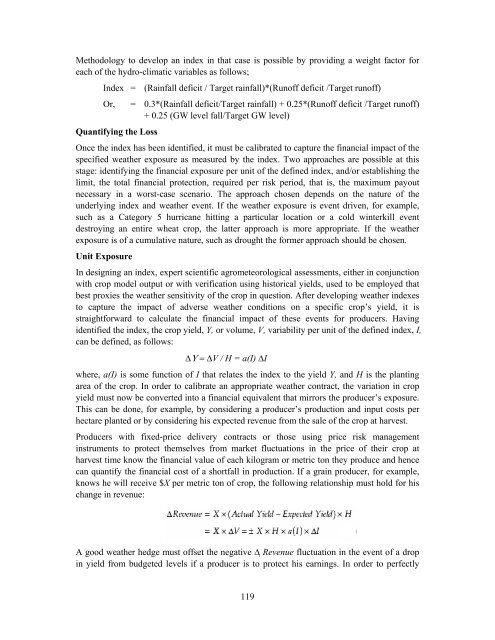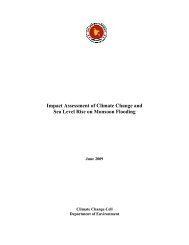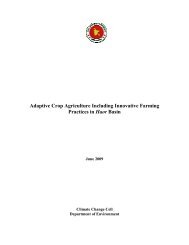Crop Insurance as a Risk Management Strategy in Bangladesh
Crop Insurance as a Risk Management Strategy in Bangladesh
Crop Insurance as a Risk Management Strategy in Bangladesh
Create successful ePaper yourself
Turn your PDF publications into a flip-book with our unique Google optimized e-Paper software.
Methodology to develop an <strong>in</strong>dex <strong>in</strong> that c<strong>as</strong>e is possible by provid<strong>in</strong>g a weight factor for<br />
each of the hydro-climatic variables <strong>as</strong> follows;<br />
Index = (Ra<strong>in</strong>fall deficit / Target ra<strong>in</strong>fall)*(Runoff deficit /Target runoff)<br />
Or, = 0.3*(Ra<strong>in</strong>fall deficit/Target ra<strong>in</strong>fall) + 0.25*(Runoff deficit /Target runoff)<br />
+ 0.25 (GW level fall/Target GW level)<br />
Quantify<strong>in</strong>g the Loss<br />
Once the <strong>in</strong>dex h<strong>as</strong> been identified, it must be calibrated to capture the f<strong>in</strong>ancial impact of the<br />
specified weather exposure <strong>as</strong> me<strong>as</strong>ured by the <strong>in</strong>dex. Two approaches are possible at this<br />
stage: identify<strong>in</strong>g the f<strong>in</strong>ancial exposure per unit of the def<strong>in</strong>ed <strong>in</strong>dex, and/or establish<strong>in</strong>g the<br />
limit, the total f<strong>in</strong>ancial protection, required per risk period, that is, the maximum payout<br />
necessary <strong>in</strong> a worst-c<strong>as</strong>e scenario. The approach chosen depends on the nature of the<br />
underly<strong>in</strong>g <strong>in</strong>dex and weather event. If the weather exposure is event driven, for example,<br />
such <strong>as</strong> a Category 5 hurricane hitt<strong>in</strong>g a particular location or a cold w<strong>in</strong>terkill event<br />
destroy<strong>in</strong>g an entire wheat crop, the latter approach is more appropriate. If the weather<br />
exposure is of a cumulative nature, such <strong>as</strong> drought the former approach should be chosen.<br />
Unit Exposure<br />
In design<strong>in</strong>g an <strong>in</strong>dex, expert scientific agrometeorological <strong>as</strong>sessments, either <strong>in</strong> conjunction<br />
with crop model output or with verification us<strong>in</strong>g historical yields, used to be employed that<br />
best proxies the weather sensitivity of the crop <strong>in</strong> question. After develop<strong>in</strong>g weather <strong>in</strong>dexes<br />
to capture the impact of adverse weather conditions on a specific crop’s yield, it is<br />
straightforward to calculate the f<strong>in</strong>ancial impact of these events for producers. Hav<strong>in</strong>g<br />
identified the <strong>in</strong>dex, the crop yield, Y, or volume, V, variability per unit of the def<strong>in</strong>ed <strong>in</strong>dex, I,<br />
can be def<strong>in</strong>ed, <strong>as</strong> follows:<br />
∆Υ = ∆V / H = a(I) ∆I<br />
where, a(I) is some function of I that relates the <strong>in</strong>dex to the yield Y, and H is the plant<strong>in</strong>g<br />
area of the crop. In order to calibrate an appropriate weather contract, the variation <strong>in</strong> crop<br />
yield must now be converted <strong>in</strong>to a f<strong>in</strong>ancial equivalent that mirrors the producer’s exposure.<br />
This can be done, for example, by consider<strong>in</strong>g a producer’s production and <strong>in</strong>put costs per<br />
hectare planted or by consider<strong>in</strong>g his expected revenue from the sale of the crop at harvest.<br />
Producers with fixed-price delivery contracts or those us<strong>in</strong>g price risk management<br />
<strong>in</strong>struments to protect themselves from market fluctuations <strong>in</strong> the price of their crop at<br />
harvest time know the f<strong>in</strong>ancial value of each kilogram or metric ton they produce and hence<br />
can quantify the f<strong>in</strong>ancial cost of a shortfall <strong>in</strong> production. If a gra<strong>in</strong> producer, for example,<br />
knows he will receive $X per metric ton of crop, the follow<strong>in</strong>g relationship must hold for his<br />
change <strong>in</strong> revenue:<br />
A good weather hedge must offset the negative ∆ �Revenue fluctuation <strong>in</strong> the event of a drop<br />
<strong>in</strong> yield from budgeted levels if a producer is to protect his earn<strong>in</strong>gs. In order to perfectly<br />
119





